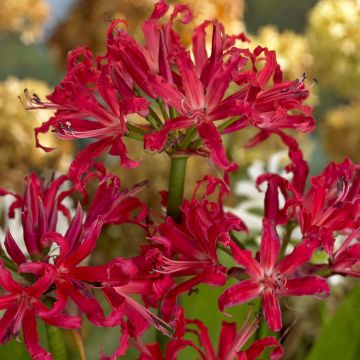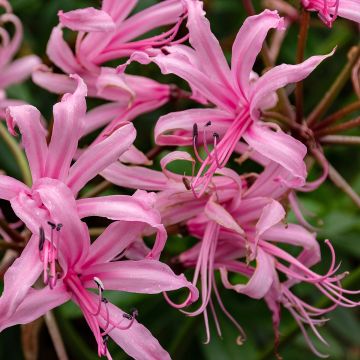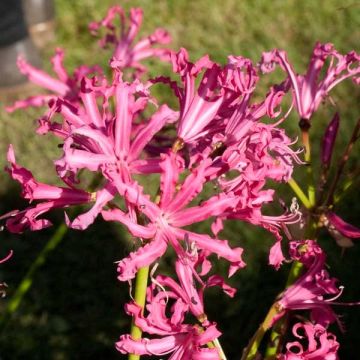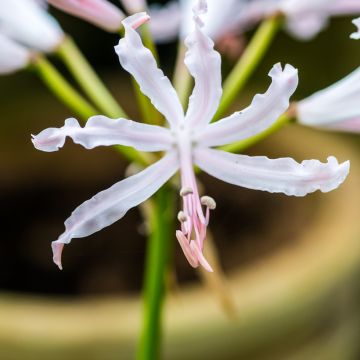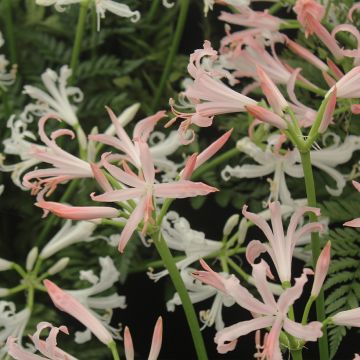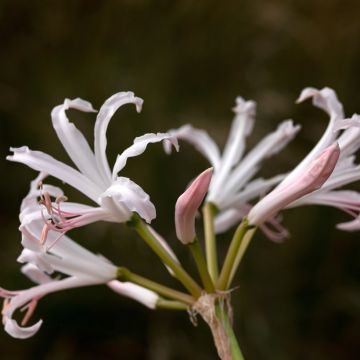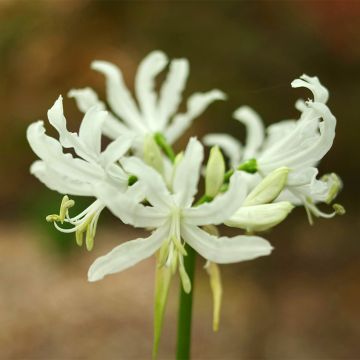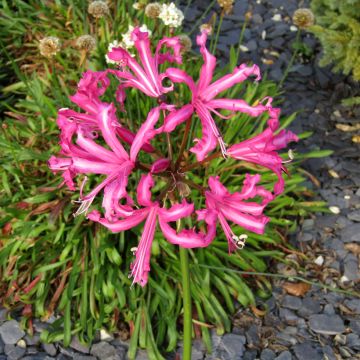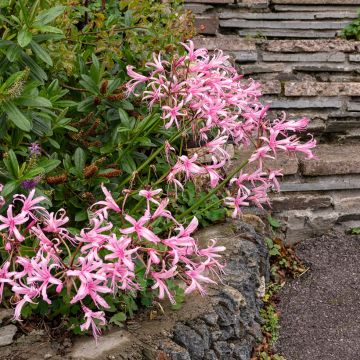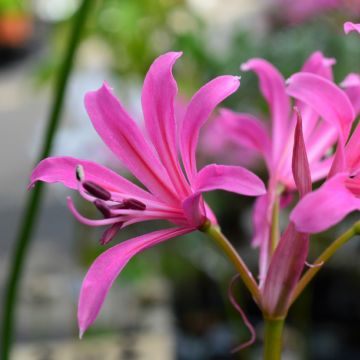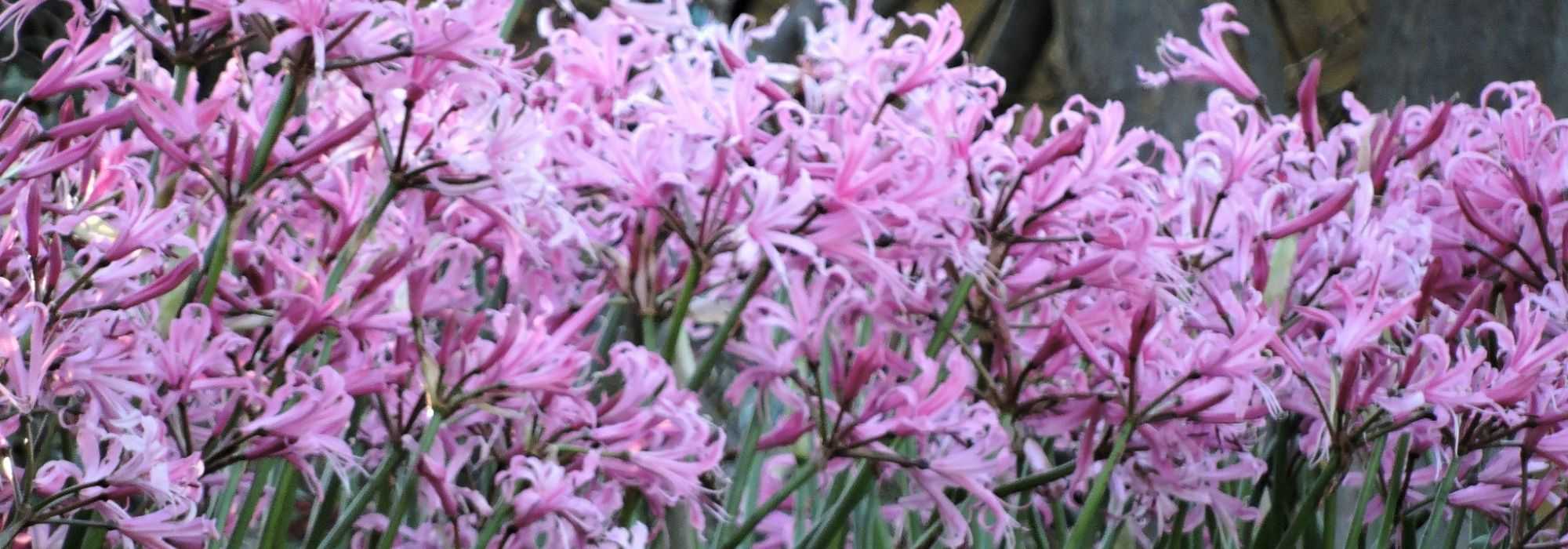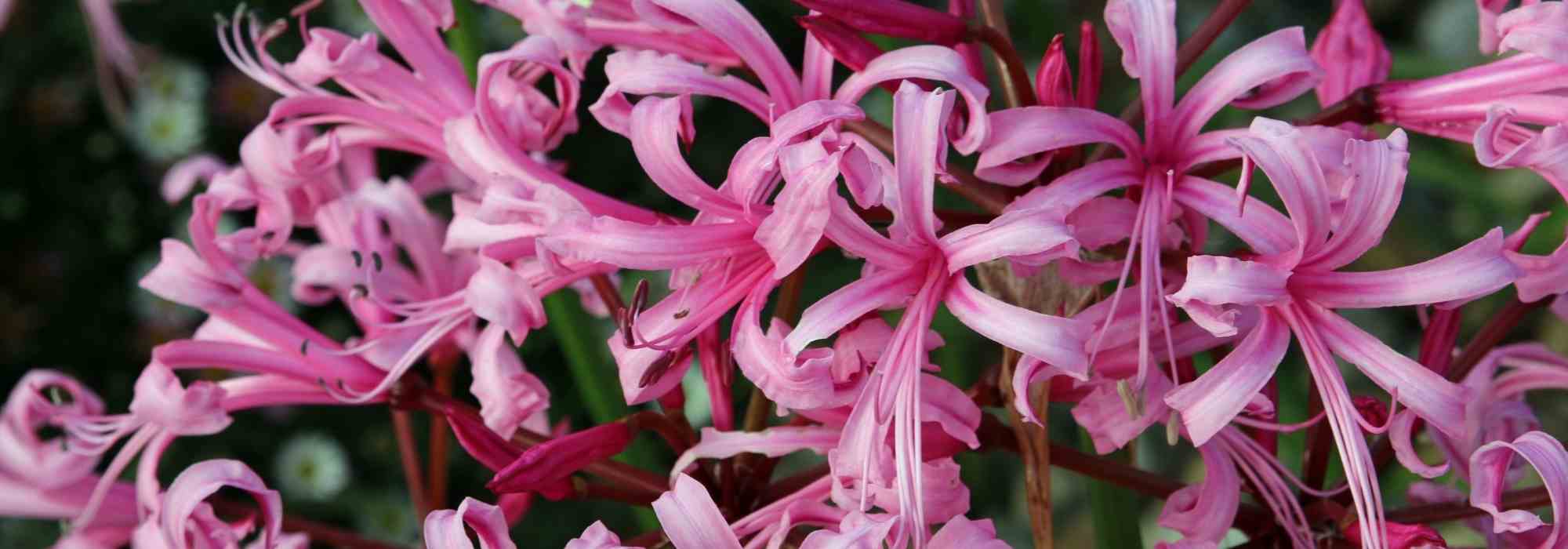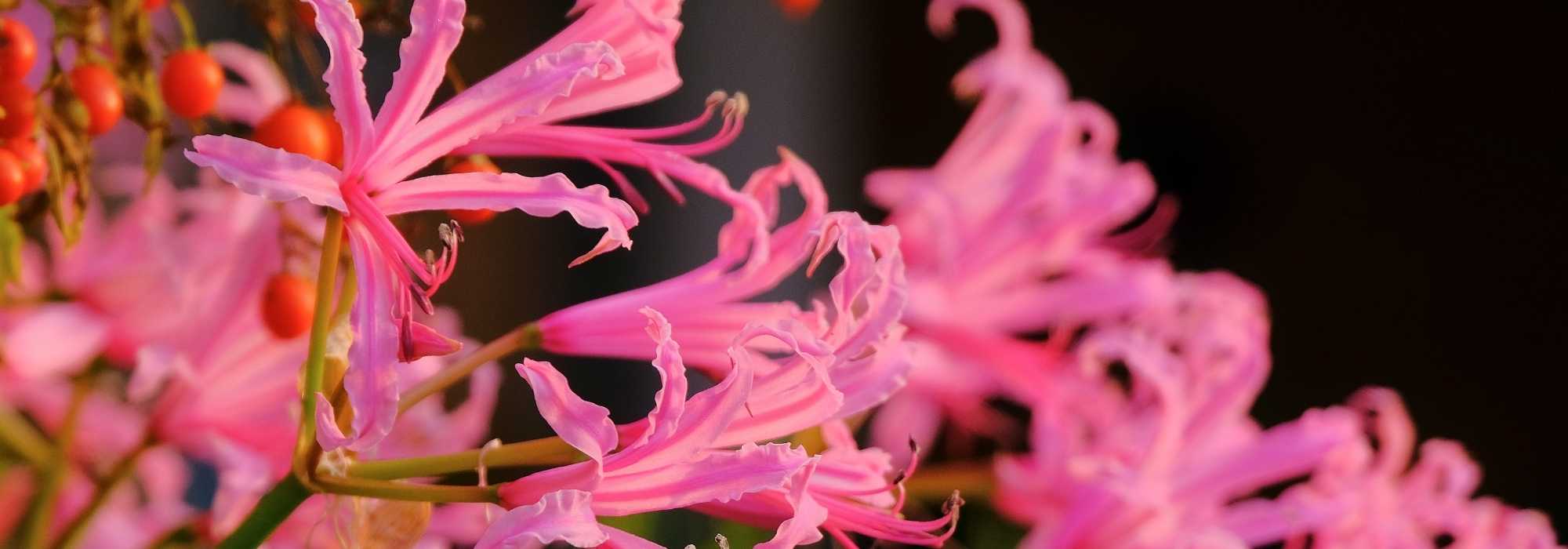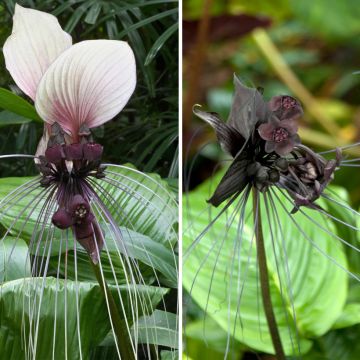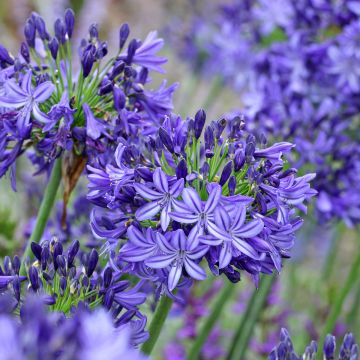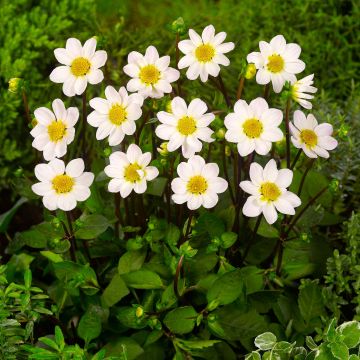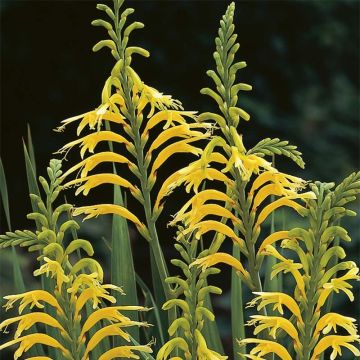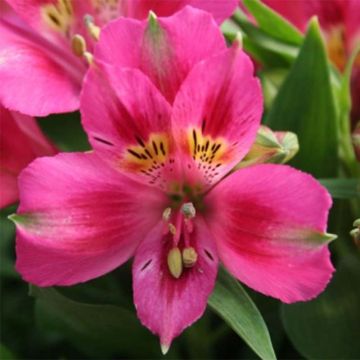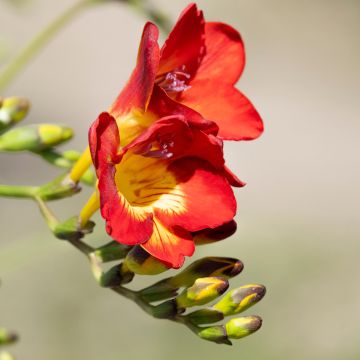

Nerine sarniensis var corusca
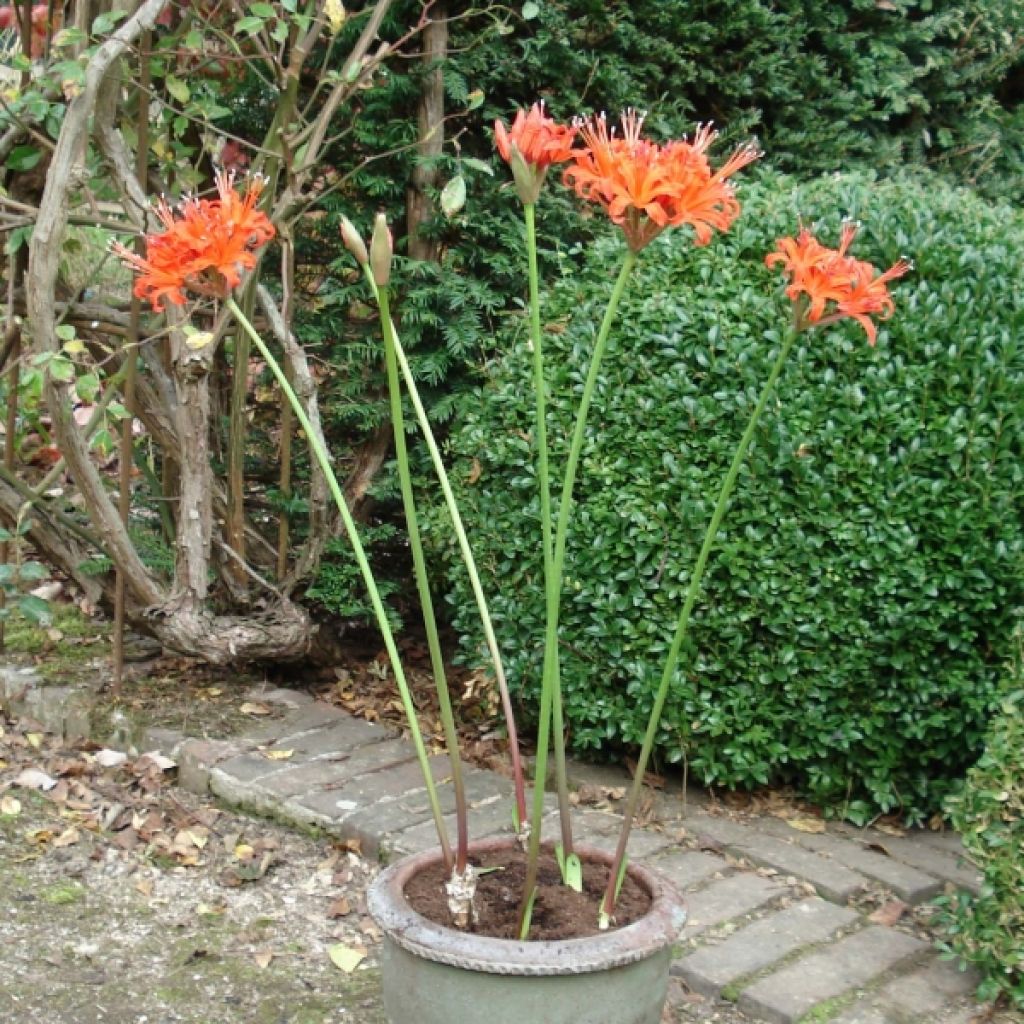

Nerine corrusca
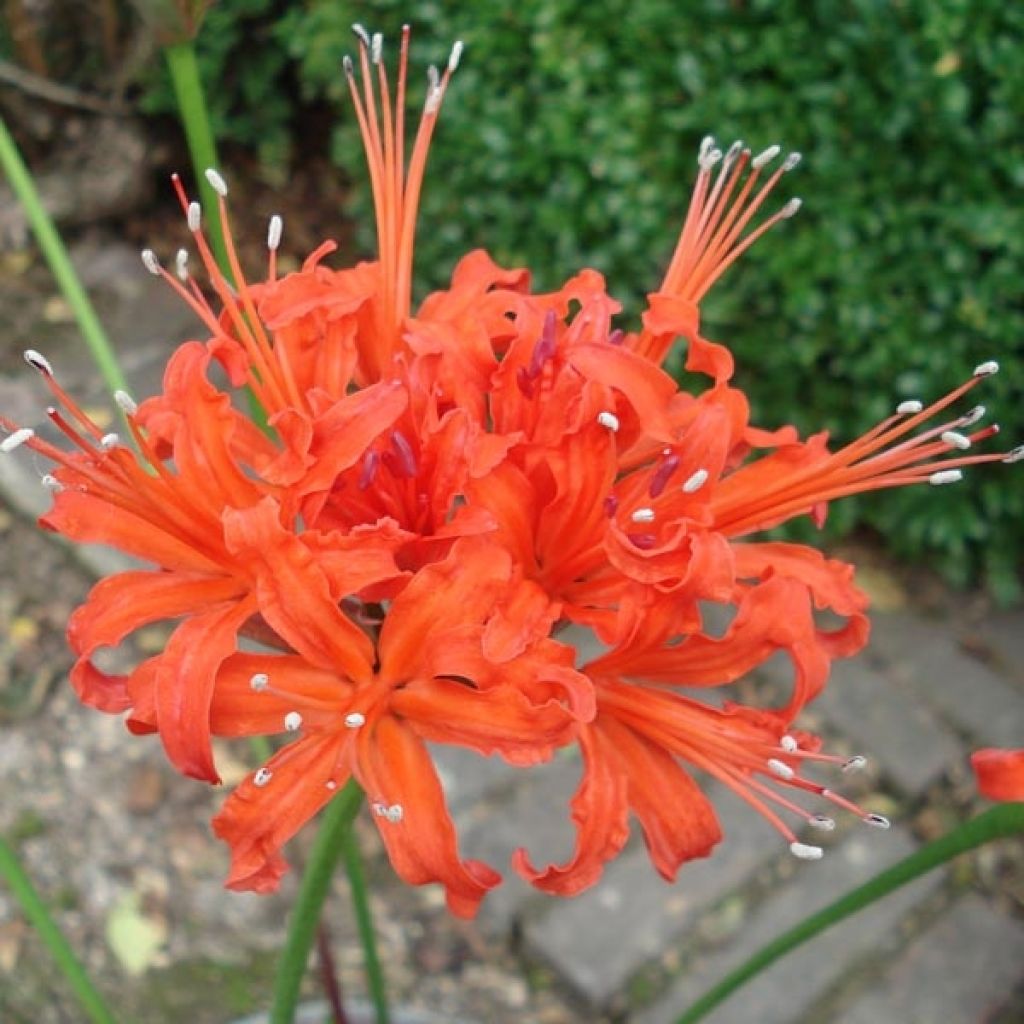

Nerine corrusca
Nerine sarniensis var. corusca
Nerine sarniensis Corusca
Guernsey Lily, Jersey Lily, Spider Lily
Bought during Promesse de fleurs' sales 4/5 years ago, the 3 bulbs, planted in a pot with pelargoniums sidoïdes and réniformis, have been blooming since the second year after planting. In autumn 2024, it was a splendor: like a huge bouquet of blood orange! Admired by gardening friends, but no merit on my part because, once in place, no care is needed! So I just ordered the nérine aurea to see if the result is equally rewarding... although the latter seems more... delicate.
Mi, 10/02/2025
Special offer!
Receive a €20 voucher for any order over €90 (excluding delivery costs, credit notes, and plastic-free options)!
1- Add your favorite plants to your cart.
2- Once you have reached €90, confirm your order (you can even choose the delivery date!).
3- As soon as your order is shipped, you will receive an email containing your voucher code, valid for 3 months (90 days).
Your voucher is unique and can only be used once, for any order with a minimum value of €20, excluding delivery costs.
Can be combined with other current offers, non-divisible and non-refundable.
Why not try an alternative variety in stock?
View all →This plant carries a 6 months recovery warranty
More information
We guarantee the quality of our plants for a full growing cycle, and will replace at our expense any plant that fails to recover under normal climatic and planting conditions.
Would this plant suit my garden?
Set up your Plantfit profile →
Description
Nerine sarniensis var. corusca, the true Guernsey Lily, is a rare bulb in cultivation that distinguishes itself from the bowdenii nerines by its brilliant red-orange flowering instead of pink. Its flower umbels are also more compact than those of its cousins. The petals, adorned with golden flakes, look beautiful in the low and yellow autumn light. This South African plant is a true Mediterranean climate plant, perfectly adapted to dry and hot summers, humid autumns, and mild winters. Nerine sarniensis is loved for its beauty and also known for its somewhat capricious nature and irregular flowering: it blooms when it decides to, and not every year. Plant it in the ground in mild climates, in a very well-draining, dry soil in summer. In colder regions, it must be grown in pots.
Nerine sarniensis var. corusca belongs to the Liliaceae or Amaryllidaceae family, depending on the classification. It is native to South Africa, specifically the Western Cape region, governed by a Mediterranean climate. This species was accidentally washed ashore from ships on the Channel Islands of Guernsey and Jersey and became naturalised there before becoming the emblematic flower of these islands. This is why it claims the name Guernsey Lily or Jersey Lily.
It is a perennial herbaceous plant with a large tunicated bulb measuring 3 to 5 cm (1 to 2in) in diameter and fleshy roots. Its vegetation is deciduous in summer but evergreen from autumn to spring. This nerine develops its floral stems in September-October, sometimes in November or December depending on the year, before the appearance of the foliage. Flower production is directly dependent on the return of rain (or watering) after a long dry summer period, which is essential for bulb ripening. The floral stalks emerge from the ground and measure approximately 50 cm (20in) high. Each one carries several small umbels of star-shaped trumpet flowers with prominent long stamens. The flowers have wavy, thick, iridescent, red-orange petals. The bright green foliage begins to develop at the time of flowering. It consists of long ribbon-like leaves measuring about 20 cm (8in) long and 1 cm (0in) wide, arranged in two rows. The leaves dry up at the end of spring, when the bulb enters dormancy. Nerine bulbs do not flower every year, so it is a good idea to plant them in groups of 12 to ensure flowers every year.
This nerine is not the hardiest plant, but it is undoubtedly one of the most beautiful. It will thrive in the ground in the mildest regions, particularly near the Mediterranean or the mild Atlantic coast. It will be sensational in a raised bed enriched with sand and dry in summer, accompanied by evergreen Agapanthus, Amaryllis belladonna, or the autumn crocus Sternbergia lutea. All these plants can be used as focal points on a terrace in an exotic or contemporary style. In a flower bed, for example, you can accompany this nerine with a carpet of silver basket and Ceratostigma plumbaginoides, which blooms in autumn on reddened foliage. In colder regions, plant the bulbs in a large pot on a sunny terrace, store it for the winter in a very bright room, watering it regularly but not excessively, and keep it dry in summer. Nerines make excellent cut flowers that are very long-lasting in a vase.
Note: Nerines are sensitive to polluted urban atmospheres.
Bulb size: 12+
Nerine sarniensis var. corusca in pictures


Plant habit
Flowering
Foliage
Botanical data
Nerine
sarniensis
Corusca
Amaryllidaceae
Guernsey Lily, Jersey Lily, Spider Lily
South Africa
Planting and care
The best period to plant nerine bulbs is summer, when it is dormant. However, they can also be planted in the spring, when their flowering may be delayed by 1 year.
Plant the bulbs at a depth of 10 cm (4in) in a well-drained and light soil, spaced 8 cm (3in) apart, in the sun. The bulbs of nerine sarniensis var. corusca are hardy to -5/-7°C (23/19.4°F) (for a short period) under these conditions. Use a mixture of garden soil, sand, and leaf compost. The soil should be dry in summer but moist throughout the flowering and growth period, from autumn to spring. In more northern regions, it is essential to grow them in pots, sheltered in a bright and well-ventilated room in winter and kept dry in summer, as soon as the foliage is dry.
Planting period
Intended location
Care
Planting & care advice
-
, onOrder confirmed
Reply from on Promesse de fleurs
Similar products
Haven't found what you were looking for?
Hardiness is the lowest winter temperature a plant can endure without suffering serious damage or even dying. However, hardiness is affected by location (a sheltered area, such as a patio), protection (winter cover) and soil type (hardiness is improved by well-drained soil).

Photo Sharing Terms & Conditions
In order to encourage gardeners to interact and share their experiences, Promesse de fleurs offers various media enabling content to be uploaded onto its Site - in particular via the ‘Photo sharing’ module.
The User agrees to refrain from:
- Posting any content that is illegal, prejudicial, insulting, racist, inciteful to hatred, revisionist, contrary to public decency, that infringes on privacy or on the privacy rights of third parties, in particular the publicity rights of persons and goods, intellectual property rights, or the right to privacy.
- Submitting content on behalf of a third party;
- Impersonate the identity of a third party and/or publish any personal information about a third party;
In general, the User undertakes to refrain from any unethical behaviour.
All Content (in particular text, comments, files, images, photos, videos, creative works, etc.), which may be subject to property or intellectual property rights, image or other private rights, shall remain the property of the User, subject to the limited rights granted by the terms of the licence granted by Promesse de fleurs as stated below. Users are at liberty to publish or not to publish such Content on the Site, notably via the ‘Photo Sharing’ facility, and accept that this Content shall be made public and freely accessible, notably on the Internet.
Users further acknowledge, undertake to have ,and guarantee that they hold all necessary rights and permissions to publish such material on the Site, in particular with regard to the legislation in force pertaining to any privacy, property, intellectual property, image, or contractual rights, or rights of any other nature. By publishing such Content on the Site, Users acknowledge accepting full liability as publishers of the Content within the meaning of the law, and grant Promesse de fleurs, free of charge, an inclusive, worldwide licence for the said Content for the entire duration of its publication, including all reproduction, representation, up/downloading, displaying, performing, transmission, and storage rights.
Users also grant permission for their name to be linked to the Content and accept that this link may not always be made available.
By engaging in posting material, Users consent to their Content becoming automatically accessible on the Internet, in particular on other sites and/or blogs and/or web pages of the Promesse de fleurs site, including in particular social pages and the Promesse de fleurs catalogue.
Users may secure the removal of entrusted content free of charge by issuing a simple request via our contact form.
The flowering period indicated on our website applies to countries and regions located in USDA zone 8 (France, the United Kingdom, Ireland, the Netherlands, etc.)
It will vary according to where you live:
- In zones 9 to 10 (Italy, Spain, Greece, etc.), flowering will occur about 2 to 4 weeks earlier.
- In zones 6 to 7 (Germany, Poland, Slovenia, and lower mountainous regions), flowering will be delayed by 2 to 3 weeks.
- In zone 5 (Central Europe, Scandinavia), blooming will be delayed by 3 to 5 weeks.
In temperate climates, pruning of spring-flowering shrubs (forsythia, spireas, etc.) should be done just after flowering.
Pruning of summer-flowering shrubs (Indian Lilac, Perovskia, etc.) can be done in winter or spring.
In cold regions as well as with frost-sensitive plants, avoid pruning too early when severe frosts may still occur.
The planting period indicated on our website applies to countries and regions located in USDA zone 8 (France, United Kingdom, Ireland, Netherlands).
It will vary according to where you live:
- In Mediterranean zones (Marseille, Madrid, Milan, etc.), autumn and winter are the best planting periods.
- In continental zones (Strasbourg, Munich, Vienna, etc.), delay planting by 2 to 3 weeks in spring and bring it forward by 2 to 4 weeks in autumn.
- In mountainous regions (the Alps, Pyrenees, Carpathians, etc.), it is best to plant in late spring (May-June) or late summer (August-September).
The harvesting period indicated on our website applies to countries and regions in USDA zone 8 (France, England, Ireland, the Netherlands).
In colder areas (Scandinavia, Poland, Austria...) fruit and vegetable harvests are likely to be delayed by 3-4 weeks.
In warmer areas (Italy, Spain, Greece, etc.), harvesting will probably take place earlier, depending on weather conditions.
The sowing periods indicated on our website apply to countries and regions within USDA Zone 8 (France, UK, Ireland, Netherlands).
In colder areas (Scandinavia, Poland, Austria...), delay any outdoor sowing by 3-4 weeks, or sow under glass.
In warmer climes (Italy, Spain, Greece, etc.), bring outdoor sowing forward by a few weeks.






























